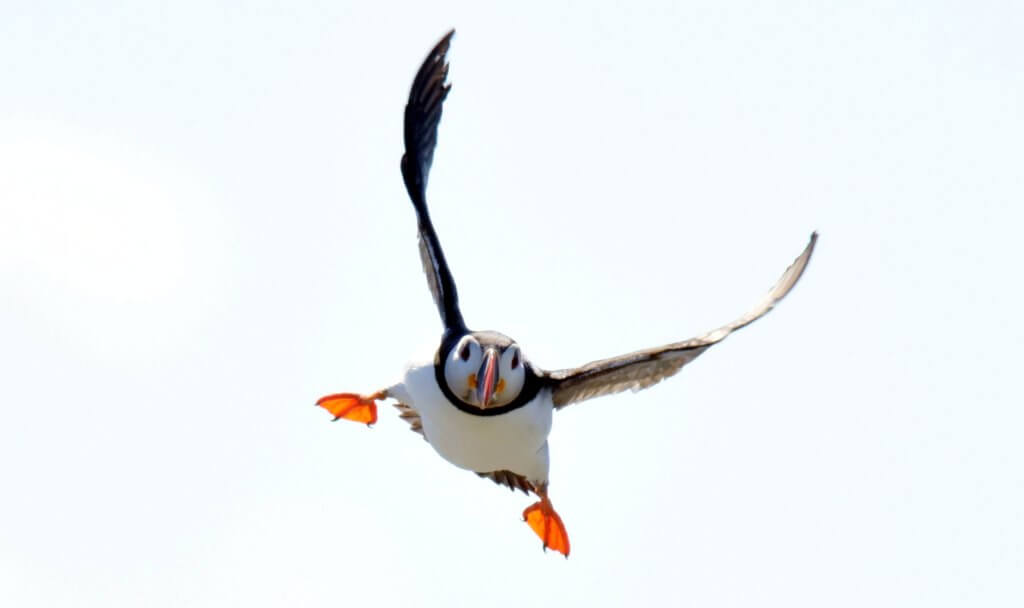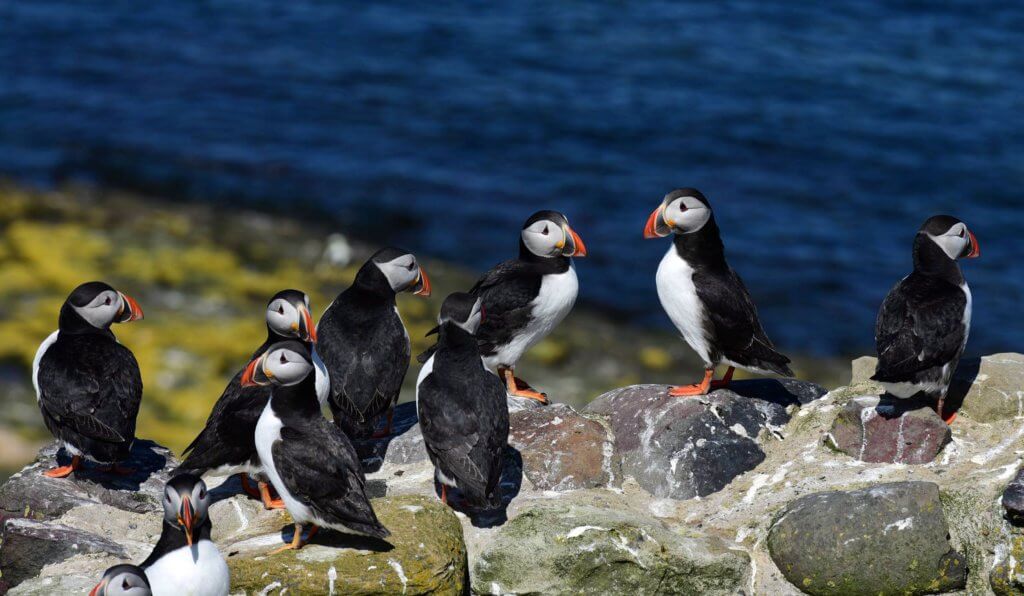
Puffin. Photo: ©National Trust Images/Paul Kingston
Farnes puffin numbers rally after initial concern in five-yearly survey results
Results from a five-yearly survey reveal puffin numbers are stable on the remote Northumberland Farne Islands, cared for by the National Trust.
Last May concerned rangers speculated that the initial low numbers from the outlying islands of this threatened seabird were due to the particularly harsh, long winter and a decline in readily available food. The fear was that this could be the case across the islands.
However, it now seems the lower numbers were an unfortunate consequence of the thriving grey seal population which has resulted in puffin burrows being inadvertently crushed on the outer islands, with more birds therefore nesting on the inner isles.

Inner Farne. Photo: ©National Trust Images/Paul Kingston
The final results, which involved checking a proportion of burrows on eight of the 28 island archipelago, show that puffin numbers have stabilised at around 44,000 pairs, nine percent higher since the last count in 2013.

Numbers of puffins on the islands have increased over the past 25 years. 37,710 pairs were recorded in 1993 with numbers peaking at 55,674 pairs in 2003 before a sudden crash in 2008 when numbers dropped by a third, before slowly recovering.
National Trust ranger, Thomas Hendry says: “’When we started the count in the outer group of islands we were very anxious that numbers were down, especially as we know puffins are struggling for survival across the globe.
After further investigations on the inner group of islands, numbers seemed to be much more positive. This could be due to the islands being more sheltered, providing an ideal habitat for the puffins to successfully breed and raise their young.
Another factor for the lower bird numbers on the outer islands could be the success of our grey seal population. We have seen seal pup numbers growing from 1,704 to 2,602 in the last five years.
A rather unfortunate consequence of this growth is the seals are competing with puffins for areas to raise their young. Although the two species are in residence and breed at different times of year, the weight of the seals could be crushing the puffin burrows and eroding surrounding vegetation.’.
Dr Chris Redfern, Emeritus Professor in the School of Natural and Environmental Sciences at Newcastle University, who helped to verify the figures was cautious about the results.
‘The count from five years ago is within the margin of error of the 2018 count. This is good news and suggests that the population of puffins on the Farne Islands overall is at least stable at the moment. However, there are indications of some re-distribution of puffins between different islands so we need to be vigilant to ensure that all islands remain in tip-top condition for this seabird to breed successfully in the future.
However, what is positive is that the results suggest that the marine environment off the Northumberland coast can still support good numbers of breeding seabirds, and indicate that these puffin colonies are not showing the declines recorded in colonies further north.‘.
Puffins have traditionally done well on the Farnes thanks to the work of the National Trust rangers, increasing protection of the marine areas around the islands, a lack of ground predators and the availability of suitable nesting areas.
The international picture for puffins, with huge productivity declines in more northerly populations, likely due to changes in their preferred food supply of sand eels, is uncertain. The risk is that climate change pressures will eventually ‘squeeze’ the Farnes population, with more and more birds having to travel further for rich feeding grounds and increased frequency of storms in the winter affecting the population at sea.
As a consequence, the Farnes team will now undertake annual surveys, but more monitoring of seabirds is needed across the country to get a better picture of the causes of seabird declines.
Harriet Reid, one of the 11 National Trust rangers that live on the islands from March to December, says: ‘Annual monitoring may help us track numbers against likely causes of population change, whether that’s changes in frequency of storms and summer rainfall as a result of climate change, changes in the sand eel population or something else altogether.
It’s important that we contribute to the worldwide picture on puffins so that we can dig deeper into trends to really discover more about what are the key factors affecting these special birds – so we know what more we can do to help.
If the root causes of seabird declines are what we suspect, it will require a bigger effort to prevent overfishing, reduce our use of single use plastics and limit our use of non-renewable energy, but it can be done.’.

Puffin. Photo: ©National Trust Images/Paul Kingston
For more information about the Farnes visit www.nationaltrust.org.uk/farne-islands. Know someone who loves puffins? The National Trust has launched a special range of donation gifts called Small Wonders – the money spent goes straight back into protecting the charity’s coastal habitats for nature. https://shop.nationaltrust.org.uk/small-wonder-gift-puffins.html
ENDS
[registration_form]
Interesting! Back in the early 1980s I worked seasonally for the National Trust on the Farne Islands and this included autumnal and early winter periods during which we monitored grey seal pup production. We also prevented grey seals from breeding on Brownsman and Staple Islands to prevent damage to the soils of these ‘Outer Group’ islands. The objective was to safeguard the breeding habitat of Puffins. What has happened over the intervening years?